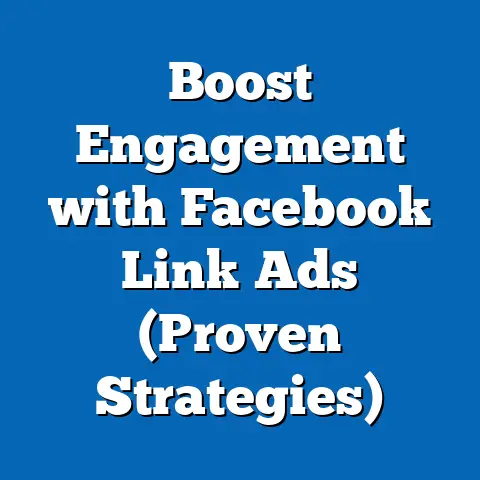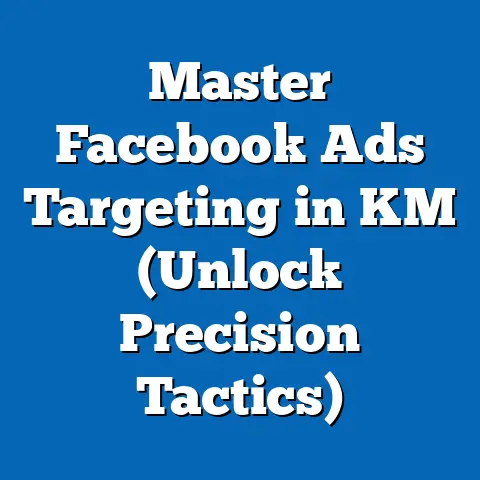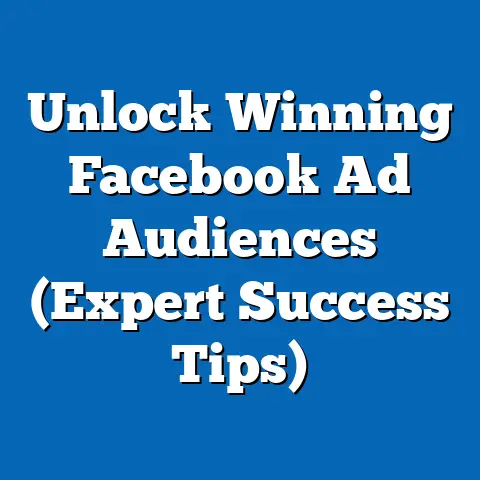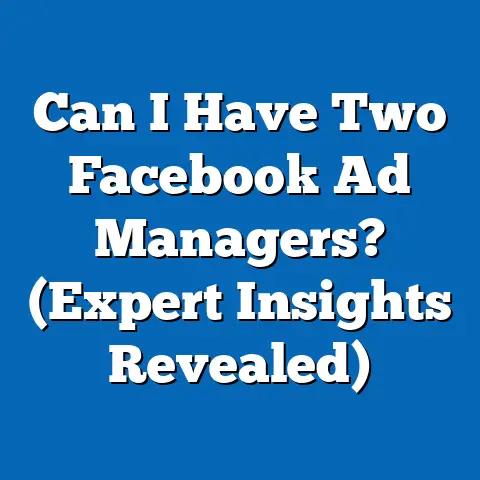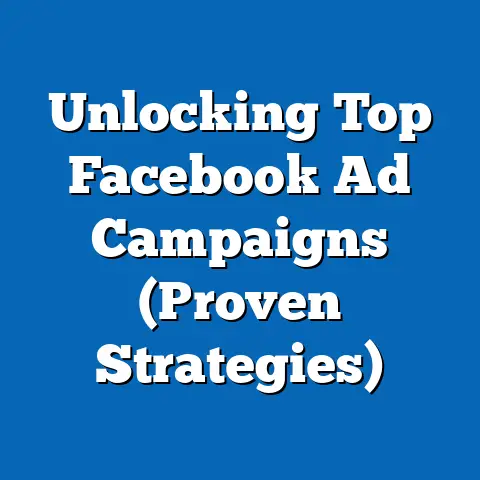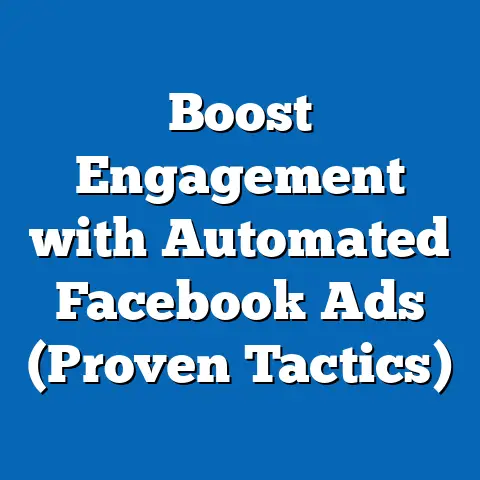Maximize Clicks with Perfect Facebook Ad Sizes (Expert Guide)
“The visual is the most powerful part of your marketing. People see before they read.” – Neil Patel
This quote from Neil Patel perfectly encapsulates why understanding and optimizing your Facebook ad sizes is absolutely crucial for success. As someone who has spent countless hours analyzing ad performance across various platforms, I can tell you firsthand that the visual impact of your ad is often the deciding factor between a scroll and a click. In this expert guide, I’ll walk you through everything you need to know to maximize your clicks by utilizing the perfect Facebook ad sizes for each format.
Understanding Facebook Ad Formats
Facebook offers a diverse range of ad formats, each designed to engage users in different ways. Choosing the right format and optimizing its size is paramount for catching attention and driving conversions. Let’s take a quick look at the major players:
- Image Ads: These are your bread-and-butter ads, consisting of a single image with accompanying text.
- Video Ads: Leveraging the power of motion, these ads can be incredibly engaging.
- Carousel Ads: This format allows you to showcase multiple images or videos within a single ad, perfect for product catalogs or storytelling.
- Slideshow Ads: A lightweight video alternative, these ads string together multiple images to create a mini-movie.
- Collection Ads: Designed for mobile shopping, these ads feature a hero image or video followed by a selection of products.
Importance of Ad Sizes
Why does ad size matter so much? Think of it this way: you’re competing for attention in a crowded marketplace. Facebook users are bombarded with content every time they open their feed. If your ad is poorly sized, blurry, or doesn’t fit the screen properly, it’s going to get lost in the noise.
Here’s why nailing the ad size is crucial:
- Visibility: Properly sized ads ensure your message is seen clearly and completely.
- Engagement: Ads that look professional and polished are more likely to capture attention and encourage clicks.
- Performance: Facebook’s algorithm favors ads that provide a good user experience. Correctly sized ads contribute to this, potentially lowering your costs and improving your reach.
- Professionalism: Using the correct ad sizes shows that you care about your brand’s image and are invested in creating a high-quality experience for your audience.
In fact, studies have shown that ads with optimized visuals can see a click-through rate (CTR) increase of up to 30%. That’s a significant boost!
Takeaway: Don’t underestimate the power of ad size. It’s a foundational element that can significantly impact your campaign’s success.
Recommended Ad Sizes for Different Formats
Now, let’s dive into the nitty-gritty: the recommended ad sizes for each format. These specifications are based on Facebook’s official guidelines and industry best practices. Keep in mind that Facebook’s recommendations can change, so it’s always a good idea to double-check the latest guidelines on the Facebook Business Help Center.
Image Ads
Image ads are simple but effective. The key is to use a high-quality image that is visually appealing and relevant to your target audience.
- Recommended Size: 1200 x 628 pixels
- Aspect Ratio: 1.91:1
- Minimum Width: 600 pixels
- Minimum Height: 315 pixels
Why these dimensions? The 1.91:1 aspect ratio ensures that your image looks good across various placements, including the Facebook feed, right column, and Audience Network. The minimum width and height ensure that your image doesn’t appear blurry or pixelated.
My Experience: I’ve found that using images with a clear focal point and minimal text overlay performs best. Remember, Facebook wants to provide a good user experience, so they tend to penalize ads that are overly promotional or cluttered.
Video Ads
Video ads are incredibly powerful for capturing attention and conveying complex messages. However, they also require careful consideration of size and resolution.
- Recommended Size: 1080 x 1080 pixels (Square) or 1920 x 1080 pixels (Landscape)
- Aspect Ratio: 1:1 (Square) or 16:9 (Landscape)
- Minimum Resolution: 1080p
- File Type: MP4 or MOV
- Maximum File Size: 4GB
Why these dimensions? Square videos are ideal for mobile viewing, as they take up more screen real estate in the feed. Landscape videos are better suited for desktop placements and can provide a more cinematic experience.
My Experience: I’ve seen great results with square video ads, especially when targeting mobile users. Keep your videos short and engaging, ideally under 15 seconds, to maximize viewer retention. Also, consider adding captions, as many users watch videos with the sound off.
Carousel Ads
Carousel ads are perfect for showcasing multiple products, highlighting different features, or telling a story.
- Recommended Size: 1080 x 1080 pixels
- Aspect Ratio: 1:1
- Minimum Cards: 2
- Maximum Cards: 10
Why these dimensions? The square format ensures that each image or video in the carousel looks consistent and visually appealing.
My Experience: I’ve used carousel ads to showcase different angles of a product, highlight its key features, and provide customer testimonials. This format is particularly effective for e-commerce businesses. Make sure to use high-quality images and compelling captions to encourage users to swipe through the carousel.
Slideshow Ads
Slideshow ads are a great way to create engaging content without the need for video production.
- Recommended Size: 1280 x 720 pixels
- Aspect Ratio: 16:9, 1:1, or 2:3
- Image Format: JPG or PNG
- Video Format: MP4 or MOV
Why these dimensions? Slideshow ads offer flexibility in terms of aspect ratio, allowing you to choose the format that best suits your images.
My Experience: I’ve used slideshow ads to create tutorials, showcase before-and-after transformations, and promote events. This format is easy to create and can be surprisingly effective.
Collection Ads
Collection ads are designed to drive sales for e-commerce businesses. They feature a hero image or video followed by a selection of products.
- Recommended Hero Image Size: 1200 x 628 pixels
- Recommended Hero Video Size: 1080 x 1080 pixels (Square) or 1920 x 1080 pixels (Landscape)
- Aspect Ratio: 1.91:1 (Hero Image), 1:1 (Hero Video Square), or 16:9 (Hero Video Landscape)
- Product Image Size: 600 x 600 pixels
Why these dimensions? Collection ads are designed to be visually appealing and easy to navigate on mobile devices.
My Experience: I’ve found that collection ads are most effective when used to promote a specific product category or collection. Make sure to use high-quality images and compelling product descriptions. Also, consider using dynamic product ads to show users products they’ve previously viewed on your website.
Takeaway: Each ad format has its own unique size requirements. Adhering to these specifications is crucial for maximizing visibility and engagement.
Creating Visually Appealing Ads
Choosing the right ad size is only half the battle. You also need to create visually appealing ads that capture attention and convey your message effectively.
Design Principles
Here are some key design principles to keep in mind:
- Whitespace: Don’t overcrowd your ad with too much text or too many elements. Use whitespace to create a clean and uncluttered look.
- Text Overlay Guidelines: Facebook recommends that text should occupy no more than 20% of the image. Use the Text Overlay Tool to check your ad’s text density.
- Color Contrast: Use colors that contrast well with each other to make your text and images stand out.
- Brand Consistency: Use your brand’s colors, fonts, and imagery to create a consistent look and feel.
- Clear Call to Action: Tell users exactly what you want them to do, whether it’s “Shop Now,” “Learn More,” or “Sign Up.”
My Experience: I’ve found that simple, clean designs with a clear call to action perform best. Avoid using overly complex or cluttered designs, as they can be distracting and confusing.
Using the Right Tools
Fortunately, there are many great design tools available that can help you create visually appealing ads in the perfect sizes. Here are a few of my favorites:
- Canva: A user-friendly design tool with a wide range of templates and features.
- Adobe Spark: A powerful design tool that offers more advanced features than Canva.
- PicMonkey: A versatile photo editing and design tool.
- Facebook Ads Manager: Facebook’s built-in ad creation tool allows you to create ads directly within the platform.
My Experience: I use Canva for most of my ad design work. It’s easy to use, affordable, and offers a wide range of templates specifically designed for Facebook ads.
Takeaway: Creating visually appealing ads is essential for capturing attention and driving engagement. Use design principles and the right tools to create ads that stand out from the crowd.
Testing and Optimizing Ad Sizes
Once you’ve created your ads, it’s time to test and optimize their performance. A/B testing is a powerful way to determine which ad sizes and formats yield the best results.
A/B Testing
A/B testing involves creating two or more versions of an ad with slight variations and then running them simultaneously to see which one performs better.
Here are some examples of A/B tests you can run:
- Image vs. Video: Test whether an image ad or a video ad performs better for your target audience.
- Square vs. Landscape: Test whether a square video ad or a landscape video ad performs better on mobile devices.
- Different Image Sizes: Test different image sizes to see which one yields the best click-through rate.
- Different Headlines: Test different headlines to see which one captures the most attention.
- Different Call to Actions: Test different call to actions to see which one drives the most conversions.
My Experience: I always recommend running A/B tests to optimize your ad performance. Even small changes can have a significant impact on your results.
Analyzing Performance Metrics
To determine which ad sizes and formats are performing best, you need to track and analyze your performance metrics. Here are some key metrics to monitor:
- Impressions: The number of times your ad was shown.
- Reach: The number of unique people who saw your ad.
- Click-Through Rate (CTR): The percentage of people who clicked on your ad after seeing it.
- Cost Per Click (CPC): The average cost you paid for each click on your ad.
- Conversion Rate: The percentage of people who completed a desired action (e.g., purchase, sign-up) after clicking on your ad.
- Return on Ad Spend (ROAS): The amount of revenue you generated for every dollar you spent on advertising.
My Experience: I use Facebook Ads Manager to track and analyze my performance metrics. I also use Google Analytics to track website conversions and attribute them to specific ad campaigns.
Takeaway: Testing and optimization are essential for maximizing your ad performance. Use A/B testing to identify the best ad sizes and formats for your target audience, and track your performance metrics to monitor your progress.
Staying Updated with Facebook’s Ad Guidelines
Facebook’s ad guidelines and size specifications are constantly evolving. It’s important to stay up-to-date with the latest changes to ensure that your ads are compliant and effective.
Regular Updates and Changes
Facebook regularly updates its ad guidelines to reflect changes in user behavior, platform features, and advertising policies. These updates can impact everything from ad sizes to text overlay restrictions.
Where to find the most current information:
- Facebook Business Help Center: This is the official source for all things Facebook advertising.
- Facebook Marketing Partners: These are companies that have been vetted by Facebook and offer expertise in advertising on the platform.
- Industry Blogs and Newsletters: Stay informed by following industry blogs and newsletters that cover Facebook advertising.
My Experience: I make it a habit to check the Facebook Business Help Center at least once a month to stay up-to-date with the latest changes.
Common Pitfalls to Avoid
Here are some common mistakes advertisers make when it comes to ad sizes:
- Using outdated dimensions: Facebook’s ad sizes change over time, so it’s important to use the latest specifications.
- Using low-quality images: Blurry or pixelated images can damage your brand’s credibility.
- Ignoring text overlay restrictions: Facebook penalizes ads that have too much text in the image.
- Not testing different ad sizes: A/B testing is essential for identifying the best ad sizes for your target audience.
- Failing to optimize for mobile: Most Facebook users access the platform on mobile devices, so it’s important to optimize your ads for mobile viewing.
My Experience: I’ve seen many advertisers make these mistakes, often without realizing it. By avoiding these pitfalls, you can significantly improve your ad performance.
Takeaway: Stay informed about Facebook’s ad guidelines and avoid common mistakes to ensure that your ads are compliant and effective.
Conclusion
Using the correct ad sizes is crucial for maximizing clicks and engagement on Facebook. By following the guidelines outlined in this article, you can create visually appealing ads that capture attention, convey your message effectively, and drive conversions. Remember to test and optimize your ads to identify the best sizes and formats for your target audience.
As Neil Patel said, “The visual is the most powerful part of your marketing.” By mastering the art of Facebook ad sizes, you can unlock the full potential of your advertising campaigns and achieve a better return on investment.
Call to Action
Now that you’re armed with this knowledge, I encourage you to start applying it to your next Facebook ad campaigns. Experiment with different ad sizes, test your results, and share your experiences in the comments below. Let’s work together to create more effective and engaging Facebook ads!

